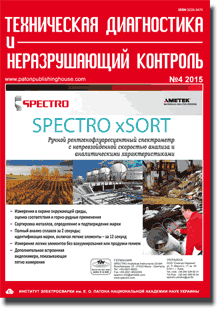| 2015 №04 (02) |
DOI of Article 10.15407/tdnk2015.04.03 |
2015 №04 (04) |

Техническая диагностика и неразрушающий контроль, №4, 2015 стр. 18-27
Разработка методики определения зависимости развития трещин в тонколистовых (обшивочных) материалах авиационных конструкций от размеров образцов
В.П. Науменко, Н.К. Кучер, Р.В. Кравчук, Е.Л. Данильчук, Р.П. Приходько
G.S. Pisarenko Institute for Problems of Strength, NASU
Реферат:
Исследовано влияние размеров пластины с центральным отверстием на развитие трещин в тонколистовых материалах. Обоснован выбор оптимальной конфигурации и размеров образца, а также приемлемого диапазона скоростей нагружения для получения упорядоченных и достаточно протяженных участков скачкообразных продвижений трещины. Определены характерные состояния трещины, которая зарождается и развивается при неизменном микромеханизме образования свободных поверхностей в условиях общей текучести. Разработана методика определения угла раскрытия вершины трещины на стадии равновесного разрушения листовых металов, а также взаимосогласованного определения деформационной и энергетической характеристик трещиностойкости в уловиях общей текучести. Конкретизирована объединенная диаграмма разрушения, устанавливающая связи между параметрами непрерывного и прерывистого роста трещины. Библиогр. 17, табл. 1, рис. 14.
Ключевые слова: листовые металлы, стесненность деформаций, прерывистое разрушение, равновесный рост трещины, профиль трещины, характерные состояния трещины
The influence of dimensions of a plate with central hole on crack propagation in sheet materials was studied. Selection of optimum configuration and dimensions of the sample, as well as of acceptable range of loading rates was substantiated, in order to produce ordered and sufficiently extended sections of abrupt advancement of the crack. Characteristic states of the crack which initiates and propagates at unchanged micromechanism of free surface formation under the conditions of total yield were determined. A procedure was developed for determination of the angle of crack tip opening at the stage of equilibrium failure of sheet metals, as well as of crack resistance under the conditions of total yield. Combined fracture diagram, correlating the parameters of continuous and intermittent crack growth, was specified. 17 References, 1 Table, 14 Figures.
Keywords: sheet metals, deformation constraint, intermittent failure, equilibrium crack growth, crack profile, characteristic crack state
- E2472–06. Standard Test Method for Determination of Resistance to Stable Crack Extension under Low–Constraint Conditions. – ASTM Standard, 2007.
- ISO 2288. Metallic Materials – Method of Test for the Determination of Resistance to Stable Crack Extension Using Specimens of Low Constraint. – Int. Standard, 2007.
- Naumenko V.P. Incorporation of length scales in plane stress fracture analysis // Proc. of the ECF16 Fract. of Nano and Eng. Materials and Structures. – E.E. Gdoutos (Ed.), Alexandropoulos, Greece. – 2006.
- Naumenko V.P., Skrypnyk Yu.D. Sensitivity of crack nucleation parameters to the geometric imperfection // Proc. ECF16 Fracture of Nano and Engineering Materials and Structures, (Ed.) E. E. Gdoutos, Alexandropoulos, Greece. – 2006.
- Naumenko V.P., Lenzion S.V. Comprehensive Assessment of a Naturally Forming Tear Crack in Thin-Sheet Aluminium Alloy // Proc. ESIA8 Conf. on Through–life Management of Structures, Manchester. – 2006.
- Naumenko V.P., Lenzion S.V., Skrypnyk Yu.D. Ductile tearing in narrow and wide strips of thin–sheet aluminium alloy // Proc. ESIA8 Through–life Management of Structuers Comp. – Manchester, 2006. – 10 p.
- Naumenko V.P., Atkins A.G. Engineering assessment of ductile tearing in uniaxial and biaxial tension // International Journal of Fatigue. – 2006. – 28. – P. 494–503. https://doi.org/10.1016/j.ijfatigue.2005.08.008
- Naumenko V.P. An engineering concept of fracture instability // Proc. ICMFF8. – Sheffield, 2007. – 8 p.
- Naumenko V.P., Lenzion S.V., Limansky I.V. Displacement-based assessment of ductile tearing under low-constraint conditions // The Open Mech. Eng. J. – 2008. – 2. – P. 40–59.
- Naumenko V.P. Limansky I.V. Energy-based assessment of ductile tearing in a thin sheet aluminium alloy // Proc. Eng. – 2009. – 1, Issue 1. – P. 63–66. https://doi.org/10.1016/j.proeng.2009.06.017
- Naumenko V.P. Through–life assessment of ductile tearing under low-constraint conditions // Proc. of 12th Int. сonf. on Fracture. – Ottawa, 2009. – 10 p.
- Науменко В., Ліманський І., Кравчук Р. Переривчасте руйнування та характерні стани тріщини // Вісн. Тернопіл. нац. техн. ун-ту. – 2014. – №4 (76). – С. 21–33.
- Ліманський І., Кравчук Р. Методика визначення параметрів навантаження зразка у моменти фіксації відеокадрів профілю тріщини // Так саме. – 2015. – №1 (77). – С. 58–63.
- Tvergaard V., Hutchinson J.W. The relation between crack growth resistance and fracture process parameters in elastic–plastic solids // J. Mech. Phys. Solids. – 1992. – 40. – P. 1377–1397. https://doi.org/10.1016/0022-5096(92)90020-3
- Sumpter J.D.G. The energy dissipation rate approach to tearing instability // Ibid. – 2004. – 71. – P. 17–37.
- Atkins A.G., Chen Z., Cotterrel B. Prediction of the energy dissipation rate in ductile crack propagation // Fatigue and Fract. of Eng. Mat. and Struct. – 2003. – 26. – P. 67–77.
- Науменко В.П., Лиманский И.В. Сопротивление разрушению листовых металлов и тонкостенных конструкций. Сообщ. 1. Критический обзор // Пробл. прочности. – 2014. – № 1. – С. 25–49.
Поступила в редакцию 04.10.2015
Подписано в печать 15.12.2015.
